Editing a Validation Scenario
To edit an existing validation scenario, follow these steps:
-
Select the
 Configure Validation Scenario(s) from the
Configure Validation Scenario(s) from the  Validation toolbar drop-down menu, or from the
menu (or the Validate submenu when invoking the
contextual menu on a file in the Project view).
The Configure Validation Scenario(s) dialog box is displayed. It contains built-in and user-defined scenarios. The built-in scenarios are organized in categories depending on the type of file they apply to and you can identify them by a yellow key icon that marks them as read-only. The user-defined scenarios are organized under a single category. The default scenarios for the particular framework are rendered in bold.Note: If a main file is associated with the current file, the validation scenarios defined in the main file, along with any Schematron schema defined in the default scenarios for that particular framework, are used for the validation. These take precedence over other types of validation units defined in the default scenarios for the particular framework. For more information on main files, see Contextual Project Operations Using 'Main Files' Support or Modular Contextual XML Editing Using 'Main Files' Support.
Validation toolbar drop-down menu, or from the
menu (or the Validate submenu when invoking the
contextual menu on a file in the Project view).
The Configure Validation Scenario(s) dialog box is displayed. It contains built-in and user-defined scenarios. The built-in scenarios are organized in categories depending on the type of file they apply to and you can identify them by a yellow key icon that marks them as read-only. The user-defined scenarios are organized under a single category. The default scenarios for the particular framework are rendered in bold.Note: If a main file is associated with the current file, the validation scenarios defined in the main file, along with any Schematron schema defined in the default scenarios for that particular framework, are used for the validation. These take precedence over other types of validation units defined in the default scenarios for the particular framework. For more information on main files, see Contextual Project Operations Using 'Main Files' Support or Modular Contextual XML Editing Using 'Main Files' Support.Figure 1. Configure Validation Scenario Dialog Box 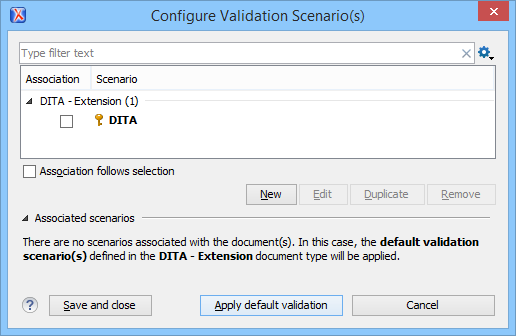 The top section of the dialog box contains a filter that allows you to search through the scenarios list and the
The top section of the dialog box contains a filter that allows you to search through the scenarios list and the Settings button allows you to configure the
following options:
Settings button allows you to configure the
following options:- Show all scenarios
- Select this option to display all the available scenarios, regardless of the document they are associated with.
- Show only the scenarios available for the editor
- Select this option to only display the scenarios that Oxygen XML Editor can apply for the current document type.
- Show associated scenarios
- Select this option to only display the scenarios associated with the document you are editing.
 Import
scenarios
Import
scenarios- This option opens the Import scenarios dialog box that allows
you to select the scenarios file that contains the scenarios you
want to import. If one of the scenarios you import is identical to an existing scenario,
Oxygen XML Editor ignores it. If a conflict appears (an imported scenario has the
same name as an existing one), you can choose between two options:
- Keep or replace the existing scenario.
- Keep both scenarios. Note: When you keep both scenarios, Oxygen XML Editor adds imported to the name of the imported scenario.
 Export selected
scenarios
Export selected
scenarios- Use this option to export selected scenarios individually. Oxygen XML Editor creates a scenarios file that contains the exported scenarios. This is useful if you want to share scenarios with others or export them to another computer.
-
Select the scenario and click the Edit button. If you try to
edit one of the read-only built-in scenarios, you will receive a warning message
that Oxygen XML Editor needs to creates customizable duplicate (you can also use the
Duplicate button).
The Edit scenario dialog box is displayed and it lists all the validation units for the scenario.
Figure 2. Edit Validation Scenario 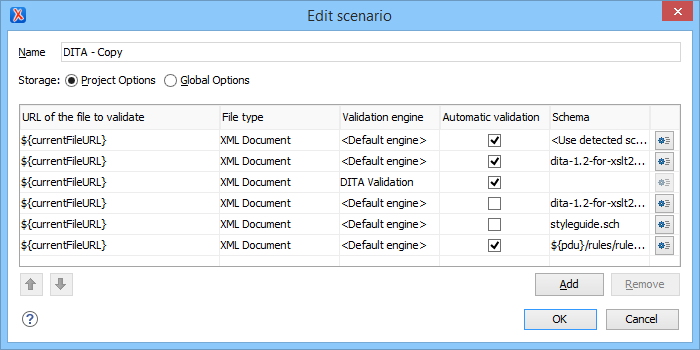 This scenario configuration dialog box allows you to configure the following information and options:
This scenario configuration dialog box allows you to configure the following information and options:- Name
- The name of the validation scenario.
- Storage
- You can choose between storing the scenario in the Project Options or Global Options.
- URL of the file to validate
- The URL of the main module that includes the current module. It is also the
entry module of the validation process when the current one is validated. To edit
the URL, double-click its cell and
specify the URL of the main module by doing one of the following:
- Enter the URL in the text field or select it from the drop-down list.
- Use the
 Browse drop-down button to
browse for a local, remote, or archived file.
Browse drop-down button to
browse for a local, remote, or archived file. -
Use the
 Insert Editor Variable button to insert an editor variable or a
custom editor
variable.
Insert Editor Variable button to insert an editor variable or a
custom editor
variable.Figure 3. Insert an Editor Variable 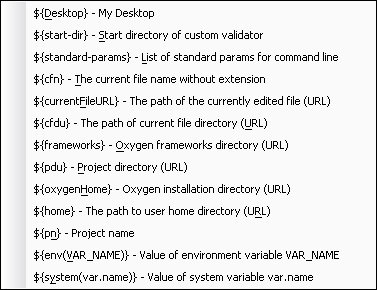
- File type
- The type of the document that is validated in the current validation unit. Oxygen XML Editor automatically selects the file type depending on the value of the URL of the file to validate field.
- Validation engine
-
You can select one of the engines available in Oxygen XML Editor for validation of the particular document type:
- Default engine - The default engine is used to run the validation for the current document type, as specified in the preferences page for that type of document (for example, XSLT preferences page, XQuery preferences page, XML Schema preferences page).
- DITA Validation engine -
Performs DITA-specific checks in the context of the specifications (it is similar to the
process when using the
 Validate and Check for
Completeness action in the DITA Maps
Manager, but for a local file rather than an entire DITA map).
Validate and Check for
Completeness action in the DITA Maps
Manager, but for a local file rather than an entire DITA map). - DITA Map Validation and Completeness
Check engine - Performs a validation process that checks the
DITA map document and all referenced topics and maps (it is similar to the
process when using the
 Validate and Check for Completeness action in the
DITA Maps Manager).
Validate and Check for Completeness action in the
DITA Maps Manager). - DITA-OT Project Validation and Completeness
Check engine - Performs a validation process that checks each
context from the provided DITA-OT project file (it is similar to the
process when using the
 Validate and Check for
Completeness action in the DITA Maps
Manager).
Validate and Check for
Completeness action in the DITA Maps
Manager). - Table Layout Validation engine - Looks for table layout problems (for more information, see the Report table layout problems option).
- Automatic validation
- If this option is selected, the validation operation defined by this row is also applied by the automatic validation feature. If the Automatic validation feature is disabled in the Document Checking preferences page, then this option is ignored, as the preference setting has a higher priority.
- Schema
- This option becomes active when you set the File type to XML Document and allows you to specify the schema used for the validation unit.
 Settings
Settings
- Depending on the selected validation engine, clicking the
 Settings button either opens the
Specify Schema dialog box or the Configure
validation engine dialog box.
Settings button either opens the
Specify Schema dialog box or the Configure
validation engine dialog box.  Move
Up
Move
Up- Moves the selected validation unit up one spot in the list.
 Move Down
Move Down- Moves the selected validation unit down one spot in the list.
- Add
- Adds a new validation unit to the list.
- Remove
- Removes an existing validation unit from the list.
- Configure any of the existing validation units according to the information above, and you can use the buttons at the bottom of the table to add, remove, or move validation units. Note that if you add a Schematron validation unit, you can also select the validation phase.
-
When you are done configuring the scenario, click OK.
The modified validation scenario will now be included in the list of scenarios in the Configure Validation Scenario(s) dialog box. If you chose to duplicate an existing one, the modified scenario will be listed with the word copy at the end of its name.

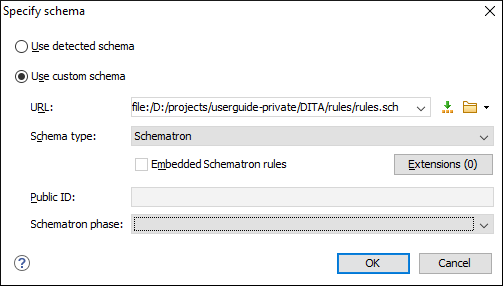
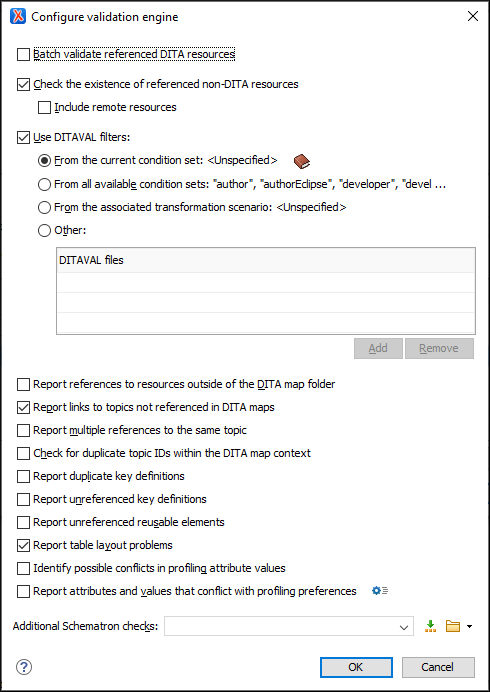
 Details
Details